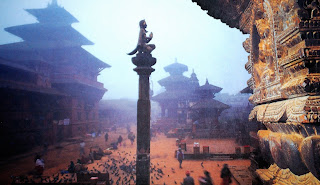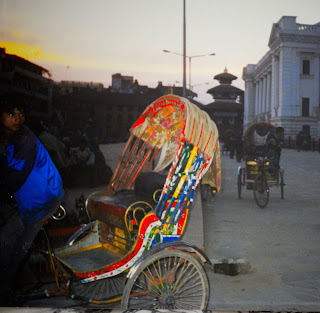NEPAL - KATHMANDU
In the year that I created my first email account, back in 1998, I also took a five day trip to Kathmandu, Nepal and it was quite an experience. The flight from Bangkok, Thailand to Kathmandu is 3.5 hours. As many know, in 2001 the crown Prince murdered his family and since 2008 Nepal is no longer led politically by a monarchy but is now a republic. Nepal was also hit by a dreadful earthquake in 2015, killing 9000 people and injuring nearly 22.000. Much of the Patan Durbar Unesco Heritage square was destroyed. Here is a postcard picture I bought, whilst it was in tact in 1998 and below, the devastation in 2015, copyright to Global Heritage Fund
Patan Durbar Square
A zoomed in view will show the delicate ornamental roof decor
Global Heritage Fund
Global Heritage Fund
My interest in Nepal was because the famous Buddha was born in Lumbini, south of Kathmandu 2500 years ago. Yet 80% of Nepalese are Hindu due to earlier history. I did not go to Lumbini but stayed in Nepal's capital Kathmandu. It has a vibrant centre during the day and especially at night, when market sellers lay out their Tibetian prayer wheels, silver plated Buddha wall hangings and beautifully ornamented bracelets and other trinkets for sale. Rickshaws offer rides, curry scented restaurants emit spicy aromas and it is pretty mystical walking the dimly lit streets. The poor sit on pavements outside basic simple concrete walled shops, yet around you are richly decorated Hindu temples, with heavily adorned ornamental roofs and walls of explicit, erotic Karma Sutra figures.
Prayer wheels
As common in Asia, incense always wafts through the air and it's a pleasure smelling sandalwood, vanilla and other soft scents as you wander about admiring old temples and Asian culture. Although there is poverty in Kathmandu, main city streets were clean and the women, even if poor, seemed to float around, dressed in their primary coloured sequined saris that flow around their
bodies elegantly like soft waterfalls.
Karma Sutra
A tiny example of the temple carvings but the explicit figures are present from floor to roof and all around archways and doors. Copyright of the picture to: http://www.nepalmtlovers.com/explore-kama-sutra-art-in-nepal.html
In the daytime, wandering the small mainly pedestrian streets, up and
down small alleys there is good shopping to be done in the line of warm mountainous colourful clothes and fabrics, especially around
the big Buddhist Statue, or in Nepalese, a Stupa. This is all in the old part of Kathmandu near Durbar Square. The old photo below is unclear but you can sense the aura as those eyes follow you like the Mona Lisa, from high above, with its colourful flags on sail type lines, flapping in the wind, from the head peak over the dome. The latter is called the mandala.
Many visit Nepal to climb mountains but as my travelling companion and I were short of time and it was autumn we took a tour with a local guide and private car through the forested, green Himalayas to see Mount Everest and have lunch, visiting some temples and sites along the way. On the way up , there were many female workers in the fields collecting mustard seeds in baskets and the odd souvenir stall along the way, with children selling rather overripe fruit. Other than than, the only hint of civilisation was a tiny concrete block shop which advertised coca-cola on a paint stripped faded wall.
Unfortunately, it was a cloudy day and upon arrival at the view point, Mount Everest was hidden behind
clouds, which is not uncommon I hear from fellow travellers. The most interesting part of our journey though was visiting a village
where regular locals were going about their daily business. As a westerner, and my friend being Thai, we were not allowed to enter a Hindu temple as locals were participating in what for us was an extremely extraordinary event. A live cremation. On concrete steps below the temple lay a body, wrapped in bright orange cloth on top of a small fire. It did not smell pleasant but as Hindu custom goes, the ashes would be scattered into the river en route to its final destination. Leaving the funeral as we arrived was a Sadhu (Baba), a religious man. They never cut their hair, live frugally as a hermit and they paint their face. In the picture below is the Sadhu with the live cremation on the steps to the bottom left.
A Sadhu
Snake charmers
Of course in this part of the world it is also customary to see snake charmers, and their music did bring the cobras out of their baskets, but I took a picture of one's python instead.
The Nepalese were friendly even talking was done with hands and fingers. Also polite, they are reserved and pleased to serve in hotels or restaurants. It was only on leaving at the airport where we encountered some stern insistence. It was apparently not allowed to leave the country with the Nepalese fresh purple and yellow flower garland. I cannot remember where I had bought it but I was a little disappointed as it was really pretty!
If you visit Nepal I would definitely suggest buying some local music. It's very good for meditation and has an ever so calming effect even if you don't meditate. Do also absolutely try the lovely Nepalese tea! Made for the winter, it is thick, brewed on a stove in bulk, thickened with a little sugar, enriched with spices cloves, cinnamon and cardamon and is called Chai.
To end this blog, here is a hotel waitor at the Mount Everest look out point restaurant dressed in traditional dress. Always smart with their long white cotton pants, long white shirt over them with a coloured waistcoat and stylish hat.













Comments
Post a Comment
Thanks for your comment!